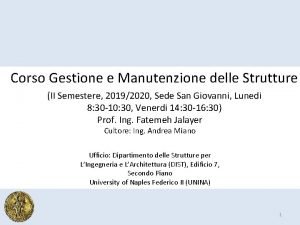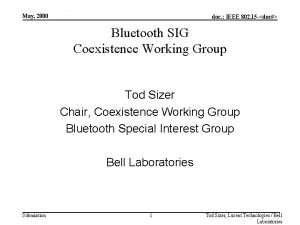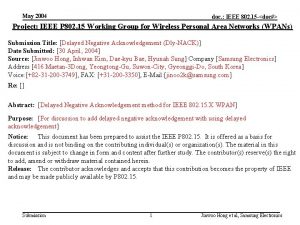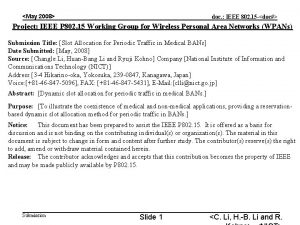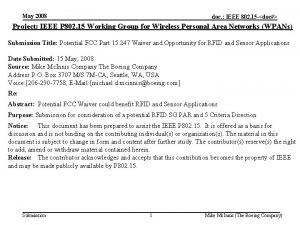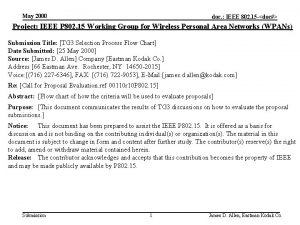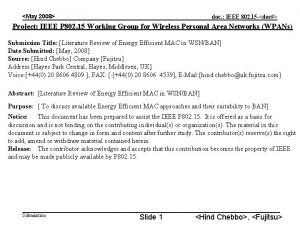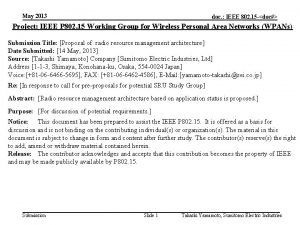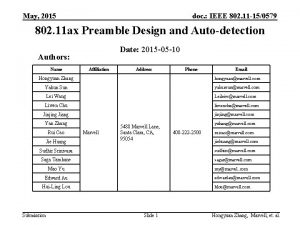May 2018 doc IEEE 802 11 180860 r











![May 2018 doc. : IEEE 802. 11 -18/0860 r 2 Reference [1] Hongyuan Zhang, May 2018 doc. : IEEE 802. 11 -18/0860 r 2 Reference [1] Hongyuan Zhang,](https://slidetodoc.com/presentation_image_h2/db95fea63c6b3f76cd968a8ce39eda4d/image-12.jpg)
- Slides: 12

May 2018 doc. : IEEE 802. 11 -18/0860 r 2 NGV PHY Feasibility Discussions Date: 2018 -05 -08 Authors: Submission Slide 1 Hongyuan Zhang, Marvell

May 2018 doc. : IEEE 802. 11 -18/0860 r 2 Introduction • NGV SG was formed to enhance throughput and possibly range from 11 p [1]. • Meanwhile [1] stresses that 11 p is sufficient for basic safety applications. • NGV PAR scope description may need to specify quantitative “performance enhancement”. • Some preliminary “estimation” on the PHY feasibility might be necessary to assist setting the PAR scope. • PHY Technology Candidates • Channelization and Coex with 11 p Submission Slide 2 Hongyuan Zhang, Marvell

May 2018 doc. : IEEE 802. 11 -18/0860 r 2 Possible More Use Cases for NGV • 11 p mostly used for basic safety: vehicles broadcast basic safety message (BSM) : vehicle status, speed, position, direction, etc. • With the goal of enhancing “rate at range”, NGV may assist with more usage cases, for example: • Enhanced safety features: more vehicle information (sensors), intention awareness, condition awareness, local HD map, etc. • Assisting autonomous driving: more intensive data communications between cars • High accuracy positioning • Infrastructure assisted, and non-broadcasting channels Submission Slide 3 Hongyuan Zhang, Marvell

May 2018 doc. : IEEE 802. 11 -18/0860 r 2 I. PHY Technology Candidates-1 • As stated in [1], there are quite some “low hanging fruits” PHY features developed along with the 802. 11 amendments in the recent decade (after 802. 11 p). • By selecting some of these existing technologies we may get enhancements especially for high throughputs and/or longer range: • • • OFDM Numerology Design: Tone Spacing, GI Duration LDPC STBC Multi-Antenna, CSD Midamble Range Extension DCM 20 MHz PHY (Ch 181, Ch 175) High Precision Positioning: FTM or 11 az based ranging Submission Slide 4 Hongyuan Zhang, Marvell

May 2018 doc. : IEEE 802. 11 -18/0860 r 2 PHY Technology Candidates-2 • PHY Parameter Comparison CV 2 X (Mode 4) 802. 11 p NGV Modulation SC-FDM OFDM Tone Spacing 15 k. Hz 156. 25 k. Hz Candidates: 156. 25 k. Hz, 78. 125 k. Hz, others? GI 4. 69 us, 5. 2 us 1. 6 us Candidates: 1. 6 us, 3. 2 us, others? Doppler Target (speed) 250 km/h 200 km/h TBD (250 km/h? ) Coding Turbo, BCC (tail biting) BCC Candidates: LDPC, others? Lowest Rate QPSK 1/3 Coding 3 Mbps (BPSK, ½) Candidates: MCS 0, MCS 0+DCM, range extension mode, others? Highest Rate 16 QAM 1/2 Coding (V 2 V) 27 Mbps (64 QAM, ¾) 256 QAM 0. 9 (e. NB Fixing at 6 Mbps for assisted) BSM broadcasting Candidates: MCS 7, MCS 9, others? Doppler Recovery Method High density DMRS (demodulation reference signal) symbols Candidates: High density midambles, others? Submission None (Up to Rx implementation) Slide 5 Hongyuan Zhang, Marvell

May 2018 doc. : IEEE 802. 11 -18/0860 r 2 PHY Technology Candidates-3 • No optional feature, since the MAC might still be based on Outside the Context of a BSS (OCB), same as 11 p. • Since original 11 p, MIMO was commonly applied in regular 802. 11 designs in 2. 4 GHz and 5 GHz, it is natural to use multi-antenna also in DSRC, e. g. 2 x 2 design. • With OCB, when multiple antenna is deployed, we may not define >1 SS rates, since there could be mixture of 1 x 1 and 2 x 2 (or larger) deployments. • Suggest only define 1 SS, and define CSD: for both NGV rates and 11 p rates. Submission Slide 6 Hongyuan Zhang, Marvell

May 2018 doc. : IEEE 802. 11 -18/0860 r 2 PHY Technology Candidates-4 • OFDM PHY Numerology Design • GI Duration –vs- Multipath –vs- Efficiency • Tone spacing –vs- Doppler Freq shift/ICI –vs- Efficiency Submission Slide 7 Hongyuan Zhang, Marvell

May 2018 doc. : IEEE 802. 11 -18/0860 r 2 Simulations-1 • Compare 11 p 1 x 1, and a new design with: • • Submission 11 ac 20 MHz down-clocked 2 x (10 MHz, 156. 25 k. Hz tone spacing) LDPC 2 x 2, 1 SS, CSD as 11 ac Midambles every 4 symbols Aggressive Highway NLOS channel model ([4]) 1000 B packet size (high throughput) Draw throughput vs SNR (extracting overheads from preamble and midambles) Slide 8 Hongyuan Zhang, Marvell

May 2018 doc. : IEEE 802. 11 -18/0860 r 2 Simulations-2 Submission Slide 9 Hongyuan Zhang, Marvell

May 2018 doc. : IEEE 802. 11 -18/0860 r 2 2. Channelization & Coex • Interoperability and/or backward compatibility with 11 p PHY is one of the highest priorities in NGV design, especially with OCB MAC! • Ch 172 (and Ch 178) is dedicated for safety where legacy 11 p device will mostly operate in with 6 Mbps (QPSK ½), may consider backward compatible/interoperable approaches, e. g. • • • Mandate NGV devices to support 11 p Tx/Rx NGV PHY backward compatible: preamble design Double transmission or based on duty cycles in the 11 p-deployed channel(s) • Other channels are mostly not occupied by 11 p devices. • May define 20 MHz NGV PHY: Ch 181, Ch 175 Submission Slide 10 Hongyuan Zhang, Marvell

May 2018 doc. : IEEE 802. 11 -18/0860 r 2 Summary • Candidate PHY technologies are discussed • It is reasonable to target NGV to achieve at least 2 x throughput gain over 11 p in aggressive Doppler channels. • Channelization and 11 p-coex are discussed Submission Slide 11 Hongyuan Zhang, Marvell
![May 2018 doc IEEE 802 11 180860 r 2 Reference 1 Hongyuan Zhang May 2018 doc. : IEEE 802. 11 -18/0860 r 2 Reference [1] Hongyuan Zhang,](https://slidetodoc.com/presentation_image_h2/db95fea63c6b3f76cd968a8ce39eda4d/image-12.jpg)
May 2018 doc. : IEEE 802. 11 -18/0860 r 2 Reference [1] Hongyuan Zhang, et al, “ 802. 11 For Next Generation V 2 X Communications”, IEEE 802. 11 -18/0513 r 2. Submission Slide 12 Hongyuan Zhang, Marvell












